Cinerama: Celebration and Citation |
Read more at in70mm.com The 70mm Newsletter |
| Written and photographed by: Mark Trompeteler, England | Date: 22.09.2010 |
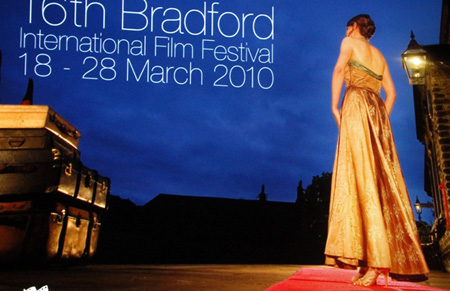 Despite
there being only one screening of an original three strip - three projector
Cinerama feature film at this year’s Widescreen Weekend at The National
Museum of Media in Bradford – all things Cinerama, and a special Cinerama
guest of honour featured very prominently. The weekend took place between
Friday 26th. and Monday 29th. March. As usual there was a mix of film
screenings, events, guest lectures, and special items. Once again delegates
from all over the world came together to view films at the museum’s
Pictureville Cinema and focus on the contribution that widescreen filming
and presentation has made to cinema culture. Despite
there being only one screening of an original three strip - three projector
Cinerama feature film at this year’s Widescreen Weekend at The National
Museum of Media in Bradford – all things Cinerama, and a special Cinerama
guest of honour featured very prominently. The weekend took place between
Friday 26th. and Monday 29th. March. As usual there was a mix of film
screenings, events, guest lectures, and special items. Once again delegates
from all over the world came together to view films at the museum’s
Pictureville Cinema and focus on the contribution that widescreen filming
and presentation has made to cinema culture. |
More in 70mm reading: Meeting Abel, Baker, and Charlie: The 2010 Bradford Widescreen Weekend There are more things in life than just widescreen! Widescreen Film Festival – Bradford 2010 |
Print Quality |
|
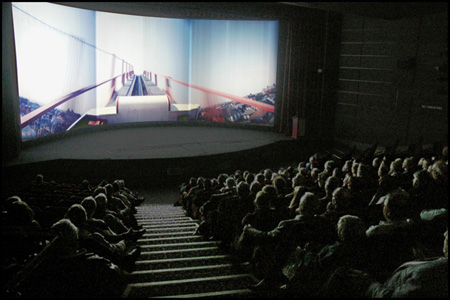 The
Friday started traditionally with a three projector three strip screening of
“This Is Cinerama.” This was followed by the film “Manhattan”. This 35mm
anamorphic print was slightly disappointing in both its contrast and
sharpness particularly as it was fairly recently made. In introducing the
film, one of the weekend’s programmers, Duncan McGregor, also the museum’s
projection manager, informed the audience that the museum endeavours to get
the best possible prints available to screen at these weekends, and that
sadly variable standards of print quality produced at some laboratories, as
well as approaches to print preservation, are issues for concern. The
widescreen weekend and other prestigious international film screenings
sometimes reveal the film industry’s very worrying approach to film
preservation and film heritage and this is obviously no criticism of film
festival organisers and programmers who work hard to foster greater
awareness of film culture, print and preservation issues. To compensate
there are many times when you can be absolutely delighted by the pristine
quality of newly made prints of classic widescreen “roadshow” movies that
have been screened at this event in previous years. Nevertheless, despite
any reservations in the quality of the print, the brilliant widescreen
compositions and black and white cinematography of New York undertaken by
cinematographer Gordon Willis shone through in one of Woody Allen’s best
films. The
Friday started traditionally with a three projector three strip screening of
“This Is Cinerama.” This was followed by the film “Manhattan”. This 35mm
anamorphic print was slightly disappointing in both its contrast and
sharpness particularly as it was fairly recently made. In introducing the
film, one of the weekend’s programmers, Duncan McGregor, also the museum’s
projection manager, informed the audience that the museum endeavours to get
the best possible prints available to screen at these weekends, and that
sadly variable standards of print quality produced at some laboratories, as
well as approaches to print preservation, are issues for concern. The
widescreen weekend and other prestigious international film screenings
sometimes reveal the film industry’s very worrying approach to film
preservation and film heritage and this is obviously no criticism of film
festival organisers and programmers who work hard to foster greater
awareness of film culture, print and preservation issues. To compensate
there are many times when you can be absolutely delighted by the pristine
quality of newly made prints of classic widescreen “roadshow” movies that
have been screened at this event in previous years. Nevertheless, despite
any reservations in the quality of the print, the brilliant widescreen
compositions and black and white cinematography of New York undertaken by
cinematographer Gordon Willis shone through in one of Woody Allen’s best
films. |
|
Print Quality |
|
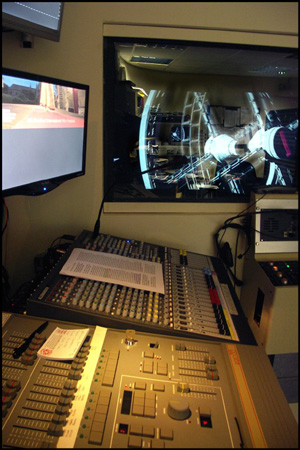 Plenty
of 70mm prints were screened, the first being “Battle of the Bulge”, shown
on the curved screen. “Battle of the Bulge” was part of a wave of film
releases in Ultra-Panavision that followed the abandonment of three strip
Cinerama as a film production and exhibition process. This wave of films
exhibited in 70mm, were often presented in Cinerama theatres on the curved
Cinerama screens. They established single lens large format widescreen
production and exhibition as the successor to Cinerama. Friday concluded
with a 70mm “blow up” print of “Die Hard.” Plenty
of 70mm prints were screened, the first being “Battle of the Bulge”, shown
on the curved screen. “Battle of the Bulge” was part of a wave of film
releases in Ultra-Panavision that followed the abandonment of three strip
Cinerama as a film production and exhibition process. This wave of films
exhibited in 70mm, were often presented in Cinerama theatres on the curved
Cinerama screens. They established single lens large format widescreen
production and exhibition as the successor to Cinerama. Friday concluded
with a 70mm “blow up” print of “Die Hard.” Saturday included a mammoth back to back screening of “2001 - A Space Odyssey”, with a discreet 6-track Dolby SR magnetic soundtrack, followed by Peter Hyam’s 1984 sequel “2010”, both in 70mm. The timely showing of “2010” this year revealed to me that it was a far better film that I remembered. Sunday provided a screening of a 35mm anamorphic, aging, but very watchable print of “The Alamo” (1960), a film that doesn’t seem to be shown very often in the UK. This 50th. Anniversary screening was sponsored by “Cinema Retro” magazine, whose publishers and editors, Lee Pfeiffer and Dave Worrall, were attending and supporting the weekend again. A very good 70mm print of the 1962 German film “Flying Clipper“ (aka “Mediterranean Holiday“) was screened after “The Alamo”. Often considered as Germany’s single lens large format answer to Cinemiracle’s “Windjammer” it was an excellent demonstration of the quality of Europe’s first single lens large format widescreen camera, the MCS-70.Three 70mm prints were screened on the Monday – “Blue Lagoon”, "Quest for Fire” and “The Hunt for Red October.” |
|
Rewriting History |
|
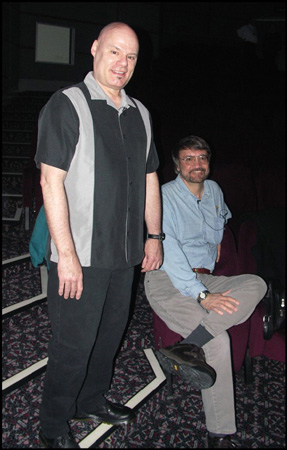 Randy
Gitsch and Dave Strohmaier. Randy
Gitsch and Dave Strohmaier.Dave Strohmaier and Randy Gitsch, leading international experts, documentary film makers and champions of widescreen and Cinerama made a welcome and popular return to the weekend as significant contributors to the event. As part of the Cineramacana event on the Sunday morning Randy Gitsch rewrote movie history in many of the minds of the audience by reminding everyone that “The Robe” was not the first 35mm anamorphic widescreen film to be theatrically released to regular paying audiences. It would appear that many parts of the anamorphic lens process were not restrictively patented and that the Dudley Picture Corporation and Vistarama caught the attention of Warner Brothers at about the same time as Fox was perfecting Cinemascope. This led to the fact that a supporting travelogue short about Hawaii was the very first 35mm anamorphic wide-screen motion picture to be released theatrically - it was Vistarama’s "Aloha Nui." It premiered at the Hollywood Paramount Theatre, 2 pm. Pacific Daylight Time, Wednesday, September 16, 1953. "The Robe" was screened several hours later in New York, at 9 pm. Eastern Daylight Time. Randy screened a print of “Aloha Nui” and many of the audience could now say they that they had seen both of the very first two “’Scope” films ever to be publically released. Other interesting items that were screened on the Sunday morning were a number of thrill ride movies, a Cinerama demonstration film and a beautiful pristine theatrical trailer for “How The West Was Won” both shown in original three strip. As mentioned above, the distinctive feature of this year’s weekend was the number of really dedicated Cinerama historians, experts and aficionados who attended – many of whom are projectionists, ex projectionists or employees of the media and broadcast industries. To begin with the traditional opening screening of the weekend of “This is Cinerama“ was introduced by Jim Morrisson who worked from 1951 onwards at Oyster Bay as part of the original Cinerama technical crew. As the weekend progressed it became more evident that such a gathering of Cinerama enthusiasts from around the world is unlikely ever to be repeated. |
|
Oyster Bay |
|
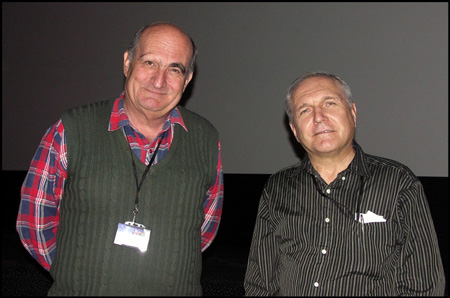 Dave
Coles and Tom March. Dave
Coles and Tom March. David Coles had travelled to Bradford from Australia having last attended in 1993 to attend the opening of “This Is Cinerama” in the then newly installed Cinerama facility. David had worked as a film projectionist for many years and had worked with 70mm. Since first seeing Cinerama in 1961 he told delegates he had become a self confessed Cineramaholic, and he is acknowledged as a stalwart of the International Cinerama Society. It was back in 1961 when he first saw an article in a Cinerama souvenir programme about the Long Island base of Cinerama operations at Oyster Bay that inspired him to embark on a life long quest to compile a near definitive history of the 15 years that Cinerama operated there in Long Island. Fred Waller, the inventor of Cinerama, had chosen to base the Cinerama operation in a large indoor tennis court building which was part of the estate and grounds of a Long Island mansion. The company also utilised a number of adjacent outbuildings. The location and nature of the building made it ideal for conversion to Cinerama’s operating base. David delivered a richly illustrated and sometimes very humorous talk on everything that went on at Oyster Bay during Cinerama’s tenure. It was an incredibly detailed account which also touched on the wealthy family of the adjoining mansion. He really has achieved the compilation of an incredible archive on the subject which he so enthusiastically shared in his presentation. |
|
John Harvey |
|
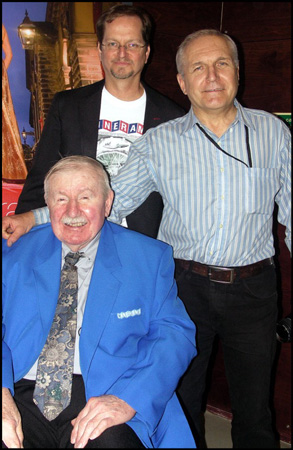 John
Harvey, Larry Smith and Tom March. John
Harvey, Larry Smith and Tom March.If there was one international universally respected Cinerama projectionist, technician, expert, collector and champion that delegates wanted to meet, talk to and shake the hand of – it was John Harvey. His close friend and former business partner Larry Smith, President of the Cinerama Preservation Society Inc., and a nitrate film specialist at the Library of Congress Audio Visual Conservation Centre, presented a conversation on stage with John Harvey about his career and life long association with Cinerama. John’s incredible life long commitment to the continuing preservation of Cinerama was also the subject of a scroll, citation and award of membership to the Academy of the Widescreen Weekend. John at the age of 16 was already a budding projectionist by being in the booth and studying the projectionist work in his local drive in theatre. When his parents took him to see Cinerama he describes it as a life changing event. In 1963, Cinerama was installed for the first time in Dayton, Ohio, at the Dabel Cinerama Theatre for the 38 week run of "How the West Was Won" where he was working as a union projectionist. He was trained by Cinerama. After the abandonment of the three strip process he continued to run movies in CinemaScope, 4-track magnetic sound, 3-D, and Todd-AO. As the years passed, he moved from projectionist to theatre technician because as he says in his own words, "I wanted to know how everything worked and how to do it better to assure the best presentation possible like I had seen Cinerama do in the fifties. Years later, in the seventies, I decided even if I had to do it all by myself, I was going to re-assemble or build from scratch the three Cinerama projectors, the seven channel stereophonic sound equipment and construct a curved Cinerama screen in my home." John spent his vacations travelling the world, scavenging parts from old theatres and junkyards and visiting technicians. He found one projector in Indianapolis, another in Europe; the third came in pieces from all over the world. He converted his ranch home in Dayton into his own personal Cinerama theatre. At first he only had six minutes of footage. But soon he had managed to piece together, from upwards of 20 sources, complete and surprisingly well-preserved prints of "How the West Was Won" and "This Is Cinerama". He attracted the attention of the world’s Cinerama enthusiasts and received international media attention, and continued to do so for many years, championing the legacy of Cinerama. John came to Bradford in March 1993 to work with Willem Bouwmeester and the Museum staff on their Cinerama installation. On June 16, 1993, Cinerama rolled again for the fist time in 21 years at a public performance in Pictureville as a part of the tenth anniversary of the Museum. Meanwhile, by the mid nineties, at the urging of his friend, Larry Smith, he brought his projectors and prints to the New Neon Theatre in Dayton. Though it used to require five skilled technicians to screen Cinerama, John developed a complex yet feasible way of synchronizing the projectors so that he could run the entire show himself. They opened with "This Is Cinerama" and it was the first time it had been publically shown in America in over 32 years. Cinerama ran here for three and a half years. A few years later, when Microsoft millionaire Paul Allen financed the re-opening of the Cinerama theatre in Seattle, his advice was sought. Several years after that, Pacific Theaters refurbished the Cinerama Dome in Hollywood and John travelled out once again to show his support and answer questions. For the first time original 6-perf Cinerama projectors were installed and new prints were struck of "This Is Cinerama" and "How the West Was Won". Once again, John played a part in Cinerama history. On Saturday, December 7, 2002, there was a special SMPTE screening of "How the West Was Won" which was the first time a 3-panel Cinerama film had ever been shown at the Cinerama Dome. Public performances followed a few months later. In 2003, after suffering a stroke and being hospitalized, the bills forced him to sell his collection of Cinerama films, equipment and memorabilia but he has never lost his enthusiasm for the process. When John was presented with his citation scroll he was also movingly re-united with a number of items that he had been forced to sell a few years ago, and the entire audience of delegates showed their very sincere appreciation of his life long work and dedication with very loud and very heartfelt warm applause. The trip to Bradford of John Harvey and Larry Smith was very generously sponsored by Canadian Cinerama enthusiast Tom March, who in a previous year had also helped sponsor a couple of superb film screenings at the weekend. |
|
Remastering Windjammer |
|
 Following
on from the life long work of John Harvey, if ever there were examples of
dedication to Cinerama by a younger generation, then the work of Dave
Strohmaier and Randy Gitsch would be fine examples. Since their visit last
year they had been working on a film to HD 2K digital mastering of probably
the best of the three strip travelogues, Cinemiracle’s “Windjammer.” They
gave a presentation on the work they had undertaken and followed this with a
screening of the 2K digital file they had produced. Following
on from the life long work of John Harvey, if ever there were examples of
dedication to Cinerama by a younger generation, then the work of Dave
Strohmaier and Randy Gitsch would be fine examples. Since their visit last
year they had been working on a film to HD 2K digital mastering of probably
the best of the three strip travelogues, Cinemiracle’s “Windjammer.” They
gave a presentation on the work they had undertaken and followed this with a
screening of the 2K digital file they had produced.They were keen to point out that what they had done was not a restoration back onto three strip film material which is what is needed and would be ideal. What they had achieved was digital scanning in of the best film material they could obtain, and then a digital “clean up” and colour restoration within the digital file and then the production of the final file. It was a kind of re-mastering, transmutation or transformation of film material to a 2K digital file. The purpose of this was to make available commercial Blu Ray DVDS of “Windjammer” that people could buy and add to their collections and make this film heritage available to the home market. This is something that could be achieved at a fraction of the cost of a full blown restoration back onto film material. The film material they based their re-mastering on was primarily based on access to three panel negatives and a 35mm anamorphic print of “Windjammer” in the Swedish Film Institute. They had to overcome many problems not least in that they were working on material that was originally shot at 26fps to produce a 2K master at 24fps – this meant synch and sound pitch problems throughout. Furthermore the 35mm anamorphic master they were working from was made by filming a flat rear “process” screen onto which the three aligned panels were projected from three ABC 6 perf. Cinerama projectors. So an actual performance of the film was photographed with a “locked off” camera capturing the three aligned panels in the one 35mm anamorphic frame. The film master was thus produced from old existing prints with all their original faults of splices, scratches, dirt and fading becoming part of the 35mm composite, which in turn had faded and had its own faults. They were working with material that already had inherent generation losses and degradations in quality. So their clean up and colour restoration in transfer to a 2K digital file was a technical challenge to say the least! In their presentation they outlined the various techniques they used to get the best possible 2K transfer they could within their very tight budget. They warned that the screening of this re-mastered 2K file on the giant Curved Cinerama screen would yield an image that wouldn’t compare to anything like the quality of the original Cinemiracle production. However what the screening of the file did present us with was “Windjammer” with a lot of restored colour, which is such an addition to the appreciation of the film over and above the faded magenta three strip print of the film that was shown at Bradford previously. The DVD of “Windjammer” should be available commercially in the not too distant future and the contribution that Dave and Randy continue to make to the preservation and championing of Cinerama heritage is truly outstanding. |
|
Cinerama’s Legacy |
|
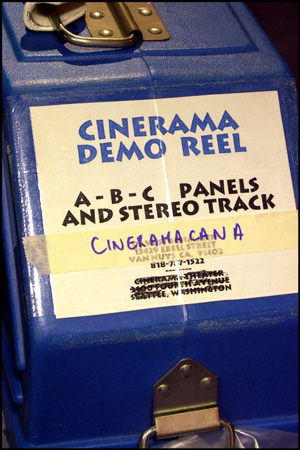 A
panel discussion on Cinerama’s legacy was held on the Sunday evening. The
panel members discussed their own various contributions in bringing about
the preservation of Cinerama exhibition, principally focusing on the
facility at Bradford. One member emphasised the fact that the projection
facility at Bradford had been secured and consolidated over many years now
and there was a priority to secure the prints that could be shown on it.
News was shared with the audience that Cinerama three strip prints stored at
the Limerick film archive in Ireland had recently been donated to the
museum. It was also mentioned that a realistic initiative to try and focus
on to celebrate the 60th anniversary of Cinerama in 2012 might be some kind
of an awareness or education initiative to introduce Cinerama to younger
people. To my mind one of the particular relevancies of Cinerama to digital
age young people is that it was a utilisation of the peak of moving image
projection technology, photographic emulsions, presentation and sound
technology of the day to produce probably the very first mass audience
immersive virtual reality or virtual world experience. Despite the breadth
of films shown at the weekend it strongly featured a thorough celebration of
all things Cinerama. A
panel discussion on Cinerama’s legacy was held on the Sunday evening. The
panel members discussed their own various contributions in bringing about
the preservation of Cinerama exhibition, principally focusing on the
facility at Bradford. One member emphasised the fact that the projection
facility at Bradford had been secured and consolidated over many years now
and there was a priority to secure the prints that could be shown on it.
News was shared with the audience that Cinerama three strip prints stored at
the Limerick film archive in Ireland had recently been donated to the
museum. It was also mentioned that a realistic initiative to try and focus
on to celebrate the 60th anniversary of Cinerama in 2012 might be some kind
of an awareness or education initiative to introduce Cinerama to younger
people. To my mind one of the particular relevancies of Cinerama to digital
age young people is that it was a utilisation of the peak of moving image
projection technology, photographic emulsions, presentation and sound
technology of the day to produce probably the very first mass audience
immersive virtual reality or virtual world experience. Despite the breadth
of films shown at the weekend it strongly featured a thorough celebration of
all things Cinerama. |
|
Programming the Future |
|
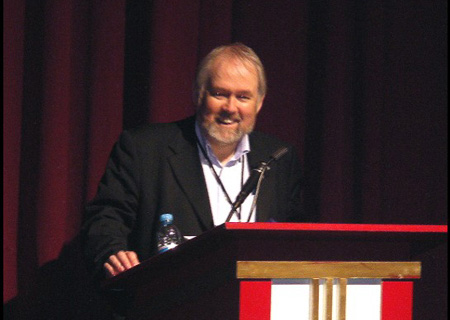 Bill
Lawrence Bill
LawrenceThomas Hauerslev, of in70mm.com, and Bill Lawrence, formerly Head of Film at the Museum, pioneered and established the Widescreen Weekend as the superb annual event it has come to be. There aren’t too many festivals where people travel from all over the world to enjoy such truly unique film exhibition facilities and share their knowledge and enthusiasm for widescreen issues. As pioneering programmer Bill is no longer a member of staff at the museum, and Thomas his fellow pioneer, who is also not a member of museum staff and was away this year through other commitments, it is not so surprising over the past year or two, to see a museum based programmer contributing to the team. It is wonderful to see the museum’s continuing commitment to this annual event, and also the announcement that Thomas, Bill and Duncan will be programming another widescreen weekend in 2011. It is an event I can thoroughly recommend and you should put Thursday 24 March - Sunday 27 March, 2011 in your diary now. |
|
| Go: back - top - back issues - news index Updated 22-01-25 |
